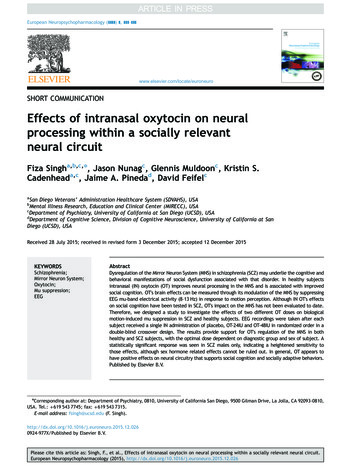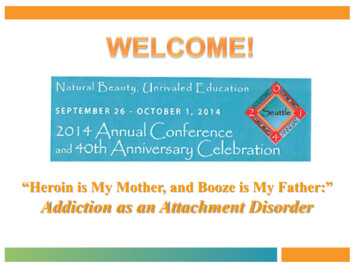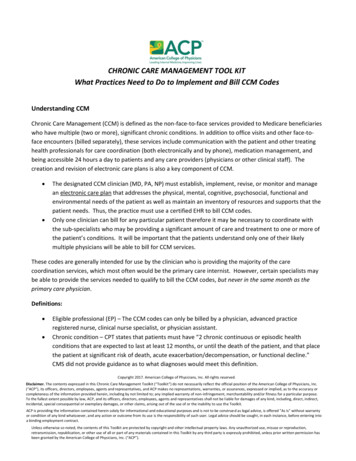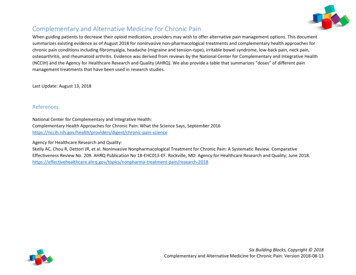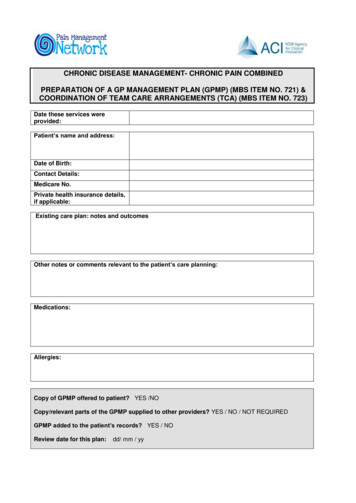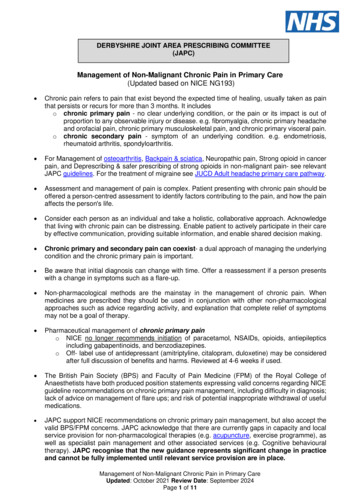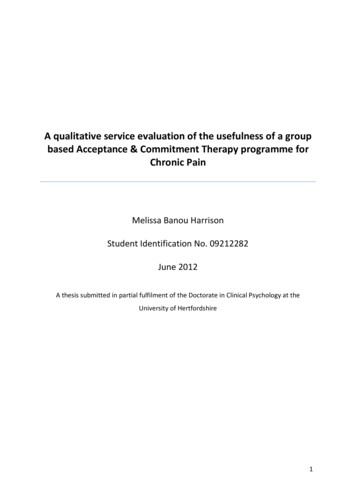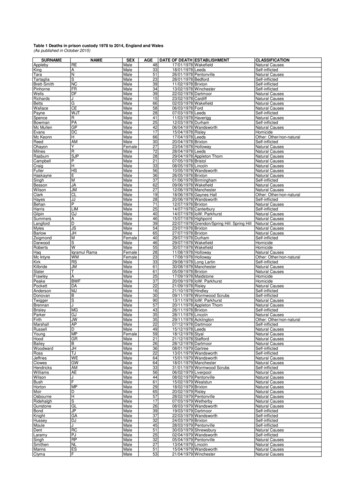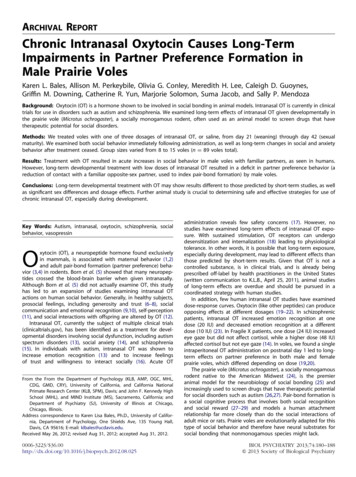
Transcription
ARCHIVAL REPORTChronic Intranasal Oxytocin Causes Long-TermImpairments in Partner Preference Formation inMale Prairie VolesKaren L. Bales, Allison M. Perkeybile, Olivia G. Conley, Meredith H. Lee, Caleigh D. Guoynes,Griffin M. Downing, Catherine R. Yun, Marjorie Solomon, Suma Jacob, and Sally P. MendozaBackground: Oxytocin (OT) is a hormone shown to be involved in social bonding in animal models. Intranasal OT is currently in clinicaltrials for use in disorders such as autism and schizophrenia. We examined long-term effects of intranasal OT given developmentally inthe prairie vole (Microtus ochrogaster), a socially monogamous rodent, often used as an animal model to screen drugs that havetherapeutic potential for social disorders.Methods: We treated voles with one of three dosages of intranasal OT, or saline, from day 21 (weaning) through day 42 (sexualmaturity). We examined both social behavior immediately following administration, as well as long-term changes in social and anxietybehavior after treatment ceased. Group sizes varied from 8 to 15 voles (n ¼ 89 voles total).Results: Treatment with OT resulted in acute increases in social behavior in male voles with familiar partners, as seen in humans.However, long-term developmental treatment with low doses of intranasal OT resulted in a deficit in partner preference behavior (areduction of contact with a familiar opposite-sex partner, used to index pair-bond formation) by male voles.Conclusions: Long-term developmental treatment with OT may show results different to those predicted by short-term studies, as wellas significant sex differences and dosage effects. Further animal study is crucial to determining safe and effective strategies for use ofchronic intranasal OT, especially during development.Key Words: Autism, intranasal, oxytocin, schizophrenia, socialbehavior, vasopressinOxytocin (OT), a neuropeptide hormone found exclusivelyin mammals, is associated with maternal behavior (1,2)and adult pair-bond formation (partner preference) behavior (3,4) in rodents. Born et al. (5) showed that many neuropeptides crossed the blood-brain barrier when given intranasally.Although Born et al. (5) did not actually examine OT, this studyhas led to an expansion of studies examining intranasal OTactions on human social behavior. Generally, in healthy subjects,prosocial feelings, including generosity and trust (6–8), socialcommunication and emotional recognition (9,10), self-perception(11), and social interactions with offspring are altered by OT (12).Intranasal OT, currently the subject of multiple clinical trials(clinicaltrials.gov), has been identified as a treatment for developmental disorders involving social dysfunction, including autismspectrum disorders (13), social anxiety (14), and schizophrenia(15). In individuals with autism, intranasal OT was shown toincrease emotion recognition (13) and to increase feelingsof trust and willingness to interact socially (16). Acute OTFrom the From the Department of Psychology (KLB, AMP, OGC, MHL,CDG, GMD, CRY), University of California, and California NationalPrimate Research Center (KLB, SPM), Davis; and John F. Kennedy HighSchool (MHL), and MIND Institute (MS), Sacramento, California; andDepartment of Psychiatry (SJ), University of Illinois at Chicago,Chicago, Illinois.Address correspondence to Karen Lisa Bales, Ph.D., University of California, Department of Psychology, One Shields Ave, 135 Young Hall,Davis, CA 95616; E-mail: klbales@ucdavis.edu.Received May 26, 2012; revised Aug 31, 2012; accepted Aug 31, 2012.0006-3223/ 025administration reveals few safety concerns (17). However, nostudies have examined long-term effects of intranasal OT exposure. With sustained stimulation, OT receptors can undergodesensitization and internalization (18) leading to physiologicaltolerance. In other words, it is possible that long-term exposure,especially during development, may lead to different effects thanthose predicted by short-term results. Given that OT is not acontrolled substance, is in clinical trials, and is already beingprescribed off-label by health practitioners in the United States(written communication to K.L.B., April 25, 2011), animal studiesof long-term effects are overdue and should be pursued in acoordinated strategy with human studies.In addition, few human intranasal OT studies have examineddose-response curves. Oxytocin (like other peptides) can produceopposing effects at different dosages (19–22). In schizophrenicpatients, intranasal OT increased emotion recognition at onedose (20 IU) and decreased emotion recognition at a differentdose (10 IU) (23). In Fragile X patients, one dose (24 IU) increasedeye gaze but did not affect cortisol, while a higher dose (48 IU)affected cortisol but not eye gaze (14). In voles, we found a singleintraperitoneal OT administration on postnatal day 1 led to longterm effects on partner preference in both male and femaleprairie voles, which differed depending on dose (19,20).The prairie vole (Microtus ochrogaster), a socially monogamousrodent native to the American Midwest (24), is the premieranimal model for the neurobiology of social bonding (25) andincreasingly used to screen drugs that have therapeutic potentialfor social disorders such as autism (26,27). Pair-bond formation isa social cognitive process that involves both social recognitionand social reward (27–29) and models a human attachmentrelationship far more closely than do the social interactions ofadult mice or rats. Prairie voles are evolutionarily adapted for thistype of social behavior and therefore have neural substrates forsocial bonding that nonmonogamous species might lack.BIOL PSYCHIATRY 2013;74:180–188& 2013 Society of Biological Psychiatry
K.L. Bales et al.BIOL PSYCHIATRY 2013;74:180–188 181Figure 1. Timeline of study procedures.In prairie voles, OT has been shown to have extensive sexspecific effects, although in both sexes it is intimately involved insocial behavior. Oxytocin is primarily responsible for pair-bondingin female voles, with the related peptide arginine vasopressin(AVP) responsible for pair-bonding in male voles (3,30–33). Adultmale voles are also responsive to OT but require higher dosagesthan female voles to induce a partner preference (4). Male volesappear to facilitate infant care behavior through either the OT orAVP system (34). In single developmental manipulations of the OTsystem, male voles appear to be more responsive to lower dosesof OT, which induce changes in partner preference (20,35), sexualbehavior, and reproductive potential (36); responses to infants(37); and AVP receptors (38). Female voles seem more resilient todevelopmental manipulations, typically responding only at higherdose of OT (19,39). Some data suggest that women may be moreresponsive to OT than men [40], but a recent meta-analysisindicated data are insufficient to analyze gender differences, evenin the best studied areas, trust and facial recognition (41).In this study, we administered three dosages of intranasal OT, ora saline control, daily to prairie voles from age 21 days to 42 days.This age range represents the period from weaning through sexualmaturity, roughly equivalent to the developmental span being usedin at least one of the clinical trials (Clinicaltrials.gov identifier:NCT01256060, Principal Investigators E. Anagnoustou and S. Jacob).We examined the acute effects of OT administration on socialinteractions with a familiar cage mate. After the end of OTadministration, we ran a series of adult tests on social and anxietybehavior to examine the long-term effects of chronic OT administration. We hypothesized that the long-term effects of chronic OTwould be sex- and dosage-dependent and not always prosocial.Specifically, we predicted that chronic developmental exposure toOT would result in disruption of critical, species-specific socialbehaviors such as formation of a partner preference, display ofalloparenting, and interactions with juveniles, especially at thehighest dosage. We predicted that anxiety-related behaviors wouldbe associated with lower normative social behavior. We alsopredicted that disruptions of social behavior would occur at lowerdosages in male voles than in female voles.with animals obtained from Dr. C. Sue Carter at the Universityof Illinois, Chicago. Voles are maintained in breeding pairs inpolycarbonate cages (44 22 16 cm), with water and food(Purina High Fiber Rabbit Chow, PMI Nutrition International,Brentwood, Missouri) ad libitum. They are on a 14:10 light cycleand maintained at approximately 701F. All procedures werereviewed and approved by the Institutional Animal Care andUse Committee of the University of California, Davis.At 20 days of age, subjects were weaned and marked withnontoxic Nyanzol D dye (American Color and Chemical Corporation, Charlotte, North Carolina) for identification. They were thenhoused in same-sex pairs in smaller cages (27 16 13 cm),with a sibling when available and a similarly aged nonsiblingwhen not available. Sixteen percent of male subjects and 21%of female subjects were housed with a nonsibling animal. Allsubjects were thus sex- and pairing-naive.Methods and MaterialsIntranasal OT TreatmentsStarting on day 21, subjects received intranasal treatments for 21days (Figure 1). Treatments were sterile saline or oxytocin (Bachem,Torrance, California) at one of three dosages: low (.08 IU/kg), medium(.8 IU/kg), or high (8.0 IU/kg). The medium dosage was based onpublicly available information regarding clinical studies in progressthat were testing the effects of OT on social deficits in autism. Themedium dosage was roughly equivalent to a weight-adjusted doseused in cited human studies. Specifically, it would be equivalent to a40 IU dosage given to a 110-lb subject. Group sizes varied from 8 to15 voles (n ¼ 89 voles total). Intranasal treatments were administeredonce per day, in the morning between 7:00 AM and 12:00 PM. A bluntcannula needle (33 gauge, 2.8 mm length; Plastics One, Roanoke,Virginia) was attached to cannula tubing, flushed, and filled with thecompound, then attached to an airtight Hamilton syringe (Bachem,Torrance, California). The animal was held still and 25 uL ofcompound was expelled slowly through the cannula needle andallowed to absorb into the nasal mucosa (divided between the twonostrils). Following administration, the animal was returned to itshome cage and familiar companion. Initial order of treatment forcage mates was randomized and then alternated on subsequent testdays. Administration was rapid (less than 30 seconds) and handlingwas consistent across treatment groups.SubjectsSubjects were prairie voles (Microtus ochrogaster) from thebreeding colony in the Department of Psychology of theUniversity of California, Davis. This colony was originally startedAcute Behavioral ObservationsTwice per week of treatment, behavioral observations wereconducted following OT administration for each animal (30www.sobp.org/journal
182 BIOL PSYCHIATRY 2013;74:180–188minutes of acute behavioral data per animal). Following OTtreatment, animals were returned to their home cage andallowed 5 minutes to resume normal activities; then, a 5minute focal observation of each cage mate was performed.The last treatment was administered on day 42. The treatmentsthus spanned from weaning (and the earliest known age ofsexual maturity) to full sexual maturity (42,43).Adult TestsWithin the 2 weeks following the end of treatment, each volereceived five behavioral tests as detailed in Figure 1. This timespan (approximately 42 days to 60 days of age) is still squarelywithin the time period of young adulthood for a prairie vole (43).All behavioral scorers (for this and other tests) were trainedagainst one primary observer (or in the case of recorded tests,against a recording previously scored by a primary observer). Allobservers were trained to 95% or greater reliability on allbehaviors before they were allowed to score actual sessions.Tests were either scored live or recorded and scored later, in eithercase using Behavior Tracker 1.5 (www.behaviortracker.com).Alloparental Care TestingAlloparental care tests are 10-minute tests in which the volehas access to two cages, an empty cage and a cage containing a0- to 4-day old pup (34). Many nulliparous rodents find pups tobe an aversive stimulus (44); however, male prairie voles areoverwhelmingly alloparental with approximately 70% to 80%acting parentally upon first exposure to a pup (37,45). Virginfemale prairie voles, on the other hand, are less likely to bealloparental and more likely to attack pups (37,45,46).Elevated Plus-Maze TestingThe elevated plus-maze (EPM) tests anxiety and exploration(47,48) by exploiting preference to remain in dark, enclosedplaces. The EPM consisted of two open and two closed opaquearms, each 67 cm long and 5.5 cm wide (48), elevated 1 m abovethe floor. Vole behavior in the maze has been shown to beresponsive to early experience (49) and pharmacologic manipulations (50). Each vole was placed in the center of the EPM andits behavior scored for 5 minutes.Open Field TestingThe open field test also tests anxiety and exploration in prairievoles (51) and other rodents (47,52) . Time spent in the center ofthe open field is interpreted as exploratory behavior, while timealong the edges is interpreted as escape or anxiety behavior. Theopen field consisted of a 40 40 40 cm Plexiglas box withgrids marked on the floor. The vole was placed in the center ofthe arena and behavior was digitally recorded for 10 minutes andscored as per Olazabal and Young (51).Juvenile Affiliation TestingA 15- to 20-day old juvenile vole placed in a two-chamberarena provides a friendly, nonthreatening stimulus (53,54) toevaluate social motivation. Behavior toward the juvenile wasdigitally recorded for 10 minutes.Partner Preference TestingThis is an operational index of pair-bond formation (55), usedextensively with prairie voles to investigate the effects ofhormones and early experience on pair-bonding (4,35,56,57). Thetest vole was given a cohabitation period with an opposite-sexwww.sobp.org/journalK.L. Bales et al.partner (6 hours for female voles, 24 hours for male voles)previously shown to be sufficient for formation of a partnerpreference (58). Prairie voles are induced ovulators that normallystart displaying lordosis between 42 and 68 hours after exposureto a strange, naive male vole, with a median of 52 hours (59). Forfemale subjects, therefore, we did not expect mating during the6-hour cohabitation period or subsequent preference testing.Only one female subject mated during the partner preferencetest (a low-dose OT-treated subject that mated with the strangemale). Male subjects were paired with intact, nonestrogen primedstimulus female subjects, which also should theoretically nothave entered behavioral estrus during the cohabitation period,but should have been a much more attractive social partner for anormal male prairie vole than a strange female not in estrus.Following cohabitation, test and stimulus voles (partner andstranger) were placed in a three-chamber apparatus. The partneranimal, as well as a stranger of the same sex, age, and approximatesize, were loosely tethered within the two end cages, while the testanimal was placed, untethered, in the empty middle cage. The testanimal could choose to spend time in either the partner’s cage, thestranger’s cage, or a third, empty cage. Tests were digitally recorded.Durations spent in each location (time spent in partner, stranger, andempty cages) were assessed, as well as duration of time spent inside-to-side contact with stimulus animals.Data AnalysisSocial behaviors measured for each social test (alloparenting,juvenile affiliation, and partner preference) differed somewhat(Tables 1–5). Throughout the testing, we were most interested inside-to-side contact, both because OT is intimately involved ingentle touch across many species and social bonds (60) andbecause this behavior has been classically measured to assesssocial bond formation in prairie voles (3,55). We also focused onapproach behaviors as reflecting the motivation to interactsocially; underlying neural substrates may involve both dopamineand OT (61,62). Anxiety was evaluated by frequency of autogrooming from each test, the number of line crosses and timespent in the center squares in the open field, and time spent inthe open arm/(time spent in the open arm time spent in theclosed arm) of the plus-maze. Other behavioral variables arepresented in Tables 1–5 but not statistically analyzed.Initially, male and female saline-treated animals were comparedfor baseline sex differences via mixed model analyses of variance(ANOVAs) (63) in SAS 9.2 (SAS Institute, Cary, North Carolina). Sexeswere then considered separately with treatment as the fixed factor.For acute observations, ID was a random factor, thus accountingfor the multiple observations on each animal. For other tests, litterwithin pair was a random factor. All significance levels were set atp o .05 and all tests were two-tailed.Data from partner preference testing were analyzed in twodifferent ways. First, time spent with partner and time spent withstranger were analyzed in separate mixed model ANOVAs asdescribed above. A second two-way ANOVA was also performedwith stimulus animal (partner or stranger) as one factor, treatment asthe second factor, and a stimulus animal by treatment interaction.ResultsAcute Behavioral ObservationsBehavioral observations starting 5 minutes following administration of OT showed acute, positive effects on interactions witha familiar cage mate in male voles (Figure 2, additional data in
BIOL PSYCHIATRY 2013;74:180–188 183K.L. Bales et al.voles increased contact with the cage mate when they receivedOT of any dosage compared with saline [F(3,227) ¼ 3.48, p ¼.017]. Social approach was also significantly affected by OT inmale voles, although effects varied by dosage, with low dosagesinhibiting approach [F(3,227) ¼ 2.97, p ¼ .033; Table 1]. Autogrooming following administration was significantly and dosedependently reduced in male voles [F(3,227) ¼ 2.74, p ¼ .044],with male voles receiving the highest dosage of OT autogrooming the least. Oxytocin administration had no effects on acutesocial behavior in female voles (Table 1).Figure 2. After acute administration of intranasal oxytocin (OT), voleswere observed with familiar cage mates. (A) Male voles increased contactat all dosages of OT [F(3,227) ¼ 3.48, p ¼ .017], while (B) female voles didnot respond to OT [F(3,237) ¼ .76, p ¼ .516]. Different letters indicatesignificant differences between means.Table 1). When considering the saline treatment only, there was asex difference in autogrooming [F(1,181) ¼ 5.08, p ¼ .026] and atrend for a sex difference in contact [F(1,181) ¼ 3.64, p ¼ .058;Table 1]; saline-treated male voles autogroomed more and spentless time in social contact than saline-treated female voles. MaleBehavioral Testing Following Long-Term TreatmentsAlloparental care tests were carried out on approximately day43, after intranasal treatment was completed. There were no sexdifferences in saline-treated animals (Table 2). The overall ANOVAsfor female contact and approach were not significant. However, asuggestive pattern emerged in which chronic intranasal exposureto low-dose OT may have affected female interactions withunrelated pups (Table 2), causing a reduction in total contact withpups when compared with saline control subjects. While therewere no significant treatment effects on male contact with pups oron autogrooming (Table 2), there was a trend for treatments toaffect approach startles [F(3,24) ¼ 2.42, p ¼ .091].Elevated plus-maze tests did not indicate any effects ofintranasal OT on anxiety (Table 3), nor were there sex differencesin saline-treated animals. In the test of interactions with a strangejuvenile, there were sex effects in saline-treated animals onautogrooming [F(1,21) ¼ 7.68, p ¼ .039] with female volesautogrooming more than male voles during this test (Table 4).There were no treatment effects on contact or approaches with astrange juvenile (Table 4).In the open field test (Table 5), there was a trend in salinetreated animals for female voles to autogroom more than malevoles [F(1,22) ¼ 5.19, p ¼ .072]. Female voles showed a treatmenteffect of OT on line crosses [F(3,26) ¼ 3.66, p ¼ .025], a measureof emotionality (47). In post hoc tests, female voles treated witheither low or medium OT treatments crossed fewer lines thanfemale voles treated with saline (Table 5).In the partner preference test, there were sex differences insaline-treated animals in time spent in contact with the partner[F(1,21) ¼ 11.09, p ¼ .045], with male voles spending more timewith the partner (Figure 3). Male voles that were treated with lowTable 1. Results of Acute Behavioral Observations Following OT AdministrationBehaviorMale VolesSocial contactSniffGroomApproachTotal playAutogroomFemale VolesSocial contactSniffGroomApproachTotal playAutogroomSalineLow OTMedium OTHigh OTn ¼ 14187.35 16.31a1.87 .475.76 1.321.76 .23a.41 .1151.1 5.7an ¼ 15208.83 12.881.50 .374.70 1.061.63 .24.41 .1134.7 4.7n ¼ 10219.61 17.0b1.00 .289.50 2.741.15 .19b.25 .1038.8 6.4a,bn ¼ 11210.23 13.732.45 .676.58 1.572.04 .32.29 .1637.1 5.8n ¼ 10225.24 14.62b1.10 .378.31 2.081.16 .21a,b.52 .1839.3 6.0a,bn ¼ 10187.52 13.932.13 .596.08 1.701.63 .20.24 .1047.1 6.9n ¼ 10210.97 19.97b2.49 .646.26 1.492.05 .33a,c.29 .1030.6 6.1bn ¼ 10204.03 14.881.81 .566.46 1.791.67 .27.39 .1234.1 5.9Differing letters indicate significant differences between treatments.OT, oxytocin.www.sobp.org/journal
184 BIOL PSYCHIATRY 2013;74:180–188K.L. Bales et al.Table 2. Results of Alloparental Care Testing in Male and Female VolesBehaviorMale VolesSniff pupLick pupRetrieveContactStartleAutogroomFemale VolesSniff pupLick pupRetrieveContactStartleAutogroomSalineLow OTMedium OTHigh OTn ¼ 14.64 .2182.64 41.131.0 .5657.86 22.631.64 .413.29 3.65n ¼ 152.07 .62185.1 32.452.40 .8768.87 28.181.73 .889.33 2.49n¼91.33 .44212.67 63.21.67 .3388.11 62.451.33 .611.33 2.69n ¼ 11.55 .3794.5 31.0.64 .3138.0 25.721.00 .387.45 3.77n ¼ 102.0 .77185.0 31.463.1 2.5654.3 23.94.9 3.1825.6 9.58n ¼ 101.30 .62139.0 35.681.50 .5118.6 40.451.30 .8829.50 14.11n ¼ 10.5 .27193.7 53.64.4 .2280.5 36.51.5 .317.5 2.57n¼91.56 .77168.2 45.441.33 .71139.7 41.93.67 .2411.56 4.23OT, oxytocin.or medium dosages of chronic intranasal OT later showed deficitsin formation of a partner preference, tested approximately 2weeks after the cessation of OT treatment (Figure 3), while femalevoles did not. Male voles showed a significant reduction in timespent with the female pair-mate [F(3,20) ¼ 3.12, p ¼ .048]. Timespent with the stranger did not differ significantly by treatment,nor did time spent in the empty cage.When analyzed with treatment as one factor and stimulusanimal (partner or stranger) as the second factor, female volesshowed a significant effect of stimulus animal [F(1) ¼ 15.97,p o .001] but no treatment effect [F(3) ¼ .10, p ¼ .961] and notreatment by stimulus interaction [F(3) ¼ .59, p ¼ .622] (Figure 3).Male voles, in contrast, showed a significant effect of stimulusanimal [F(1) ¼ 6.60, p ¼ .013], and no treatment effect [F(3) ¼ .68,p ¼ .568], but a significant treatment by stimulus animal interaction [F(3) ¼ 3.03, p ¼ .037].DiscussionThe acute effects of intranasal OT that we found hereresemble those found in many human studies, consisting of anincrease in prosocial behavior and engagement (specifically timespent in contact in male subjects) (13,15,64–66). However, in thisstudy, we were able to study long-term developmental effects ofrepeated intranasal treatments with OT. The picture that emergesis one in which dosage and sex effects are extremely important.In particular, our medium and low dosages (medium similar tothat used in human studies, while low an order of magnitudelower) changed social behavior, primarily partner preferences inmale subjects, in a potentially detrimental fashion (Figure 3).Specifically, male voles treated with low or medium doses ofOT displayed impaired formation of a pair-bond, shown by areduction of time spent with a familiar partner. Twenty-fourhours is considered more than sufficient time for male voles toform a partner preference (67). Lack of partner preferenceformation could indicate a deficit in social memory formation(68), a lack of motivation to interact with the mate (69,70), a lackof hedonic reward (71) experienced from contact with the mate,or potentially other processes that would need to be disentangled by further research. The observed changes in socialbehavior do not reflect a difference in general social motivation,as time spent alone did not differ between treatment groups.While not statistically analyzed here, other behaviors measured suggest that male voles treated with low OT also showedless interest in a strange juvenile (Table 4) (and more interest in astrange pup, Table 2), indicating perhaps altered social behaviorin multiple social contexts. Similar patterns of behavior with lowdose OT in female interactions with pups (Table 2), which dosuggest lower motivation to socially interact, also deserve furtherinvestigation and replication in a future study. It is also worthconsidering whether increased interactions with unfamiliar animals might be viewed as negative or positive, for instance, as amore general urge to affiliate. Better social interactions withstrangers might be a desirable goal in human treatments(although reduced social interactions with family and friendswould not be). In this case, however, these changes in partnerTable 3. Results of Elevated Plus-Maze Testing (Means Standard Errors)BehaviorMale VolesOpen armClosed armCenterRatioFemale VolesOpen armClosed armCenterRatioOT, oxytocin.www.sobp.org/journalSalineLow OTMedium OTHigh OTn ¼ 1494.4 16.79171.86 17.1132.0 4.9.355 .062n ¼ 15113.3 18.34145.57 18.045.87 12.67.437 .068n ¼ 1094.1 26.85177.6 27.6730.4 3.15.347 .097n ¼ 11112.9 32.0166.9 28.4628.64 5.34.389 .107n ¼ 1092.1 20.93172.2 24.5237.8 9.32.361 .088n ¼ 10108.2 26.92141.5 26.5649.0 13.3.435 .095n ¼ 10104.9 15.41160.7 13.7133.1 3.68.392 .055n¼986.67 30.16195.67 27.1525.56 5.3.298 .095
BIOL PSYCHIATRY 2013;74:180–188 185K.L. Bales et al.Table 4. Results of Juvenile Affiliation Testing (Means Standard Errors)BehaviorMale Female SalineLow OTMedium OTHigh OTn ¼ 1451.21 9.968.36 9.9419.43 4.941.21 .5319.07 6.15.43 .251.36 .71n ¼ 1437.71 6.5277.0 10.445.64 2.02.57 .4434.64 15.2124.07 13.5510.29 4.93n ¼ 1062.6 11.7849.6 12.4412.1 3.55.6 .2715.5 5.37.4 7.41.3 .99n ¼ 1133.91 8.0872.45 11.614.82 1.661.0 .7513.3 7.5510.55 8.66.64 1.44n ¼ 1051.7 7.9474.1 12.069.4 3.34.5 .1740.6 18.253.3 1.81.3 1.01n¼933.78 7.4561.33 8.492.0 .44.33 .2426.44 8.6710.11 4.303.55 2.11n ¼ 1043.0 6.2669.7 15.4712.6 2.25.3 .1513.6 4.35.6 .51.2 .73n¼953.44 13.2359.11 11.272.44 .71.00 .001.67 9.131.67 1.073.11 1.89OT, oxytocin.preference behavior are clearly species-atypical, and the apparentdirection of changes in female behavior toward pups is clearlyless nurturing.Interestingly, the impaired social behavior we observed intests does not appear to be secondary to an increase in anxiety.In fact, acutely OT-treated male voles actually showed lowerautogrooming (one measure of anxiety). Multiple measures ofanxiety across the adult tests indicated either no differencebetween OT- and saline-treated animals or a reduction inemotionality in OT-treated animals (such as in the lower numberof line crosses in the open field in OT-treated female voles). Thedetrimental changes thus appear to be relatively specific to socialbehavior.While sex differences in responses to OT are pervasive in bothadult voles (3,72) and in single-dose developmental studies(37,38,73), the human literature is still lacking in sufficientinformation to assess the impact of gender on OT response. Itwill be important in future human research to assess bothgenders at the same time and at multiple dosages. It is alsoworth emphasizing that our intranasal OT treatments were givento developing animals, for a time span chosen to approximatehumans aged 12 to 17 years. Developmental treatments can haveparticular ramifications to receptor binding and upregulation ordownregulation of peptide production (38,54,74,75). Animalresearch on additional developmental ages, as well as treatmenteffects on adults, will be important in the future. Finally, we alsoused a between-subjects design in this study and used differenttests that were developmentally appropriate for each age. Whilethis avoided design issues associated with retesting, it also did notallow us to assess changes in the same behaviors longitudinally.Future research could concentrate on tests that are well validatedthroughout development and that can be used multiple times.The possible mechanism for these changes is intriguing. If themain behavioral results had been at high dosages, a potentialculprit would be secondary binding to vasopressin receptors. Inother words, high-dose OT might saturate OT receptors andsubsequently bind to vasopressin receptors, to which OT also hasbinding affinity and which can cause differing and sometimesopposite behavioral effects (18,38,76,77). However, this explanation is less likely for the results seen here, as the low-dose OTwould not flood the receptors to the extent that the hig
We examined both social behavior immediately following administration, as well as long-term changes in social and anxiety behavior after treatment ceased. Group sizes varied from 8 to 15 voles (n ¼ 89 voles total). Results: Treatment with OT resulted in acute increases in social behavior in male voles with familiar partners, as seen in humans.
